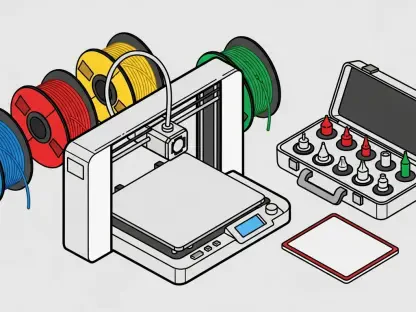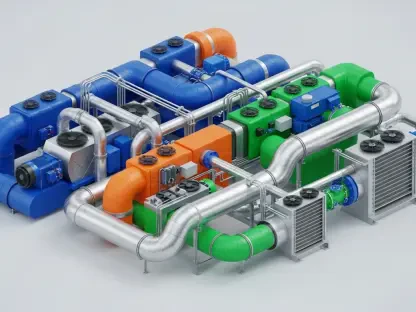In an era where connectivity drives efficiency, the once-impenetrable barrier known as the air gap, which physically separated industrial systems from external networks, is rapidly dissolving, leaving critical infrastructure vulnerable. Companies, in pursuit of cost savings and operational streamlining, are increasingly linking operational technology (OT) systems with corporate IT networks, dismantling a crucial layer of defense. This convergence exposes previously isolated environments—think manufacturing plants, energy grids, and even hospital wards—to the same cyber threats that plague IT infrastructures. A seemingly innocuous phishing email can now spiral into a catastrophic breach, disrupting critical infrastructure from a factory floor to a national power supply. While governments and agencies like the National Security Agency (NSA) and the Cybersecurity and Infrastructure Security Agency (CISA) are issuing guidelines and pushing legislation to curb these risks, true protection hinges on actionable strategies. Skills development, robust system security, and cohesive teamwork stand as the pillars of defense in this evolving threat landscape.
1. Rising Threats in a Connected World
The erosion of the air gap marks a pivotal shift in cybersecurity challenges, as critical systems once shielded by physical separation are now accessible to digital attackers. Environments that operated in complete isolation, such as oil pipelines and water treatment facilities, are becoming vulnerable to threats that start with a single compromised IT endpoint. The simplicity of these attack vectors is alarming—malicious emails or unsecured devices can serve as entry points, allowing threats to cascade into OT systems with devastating consequences. This integration, while beneficial for operational efficiency, has opened a Pandora’s box of risks, where a breach in an office network can directly impact physical infrastructure. The stakes are unimaginably high when considering that disruptions can halt production lines, cut power to entire regions, or endanger public safety in medical settings. Addressing this vulnerability requires more than just awareness; it demands a fundamental rethinking of how security is approached across interconnected domains.
Beyond the technical exposure, the human element plays a critical role in this escalating threat landscape. Many organizations lack the specialized knowledge needed to secure OT environments, often leaving IT teams to manage systems outside their expertise. This gap in skills and visibility creates fertile ground for attackers who exploit familiar IT weaknesses to penetrate industrial networks. Data indicates that a staggering 85% of OT attacks originate from IT breaches, underscoring the urgent need for integrated defense mechanisms. Governments are responding with frameworks and mandates, yet these measures often fall short without practical implementation. The reality is that attackers do not wait for policies to catch up; they strike where defenses are weakest. As connectivity continues to blur the lines between digital and physical systems, the imperative to build robust, proactive security strategies has never been clearer.
2. Addressing the Skills and Visibility Deficit
A recent report on operational technology security reveals a troubling statistic: half of all organizations have encountered cybersecurity incidents within their OT systems, largely due to inadequate preparedness. Many companies delegate OT security to IT teams without providing additional resources or specialized training, leaving these teams ill-equipped to handle the unique challenges of industrial environments. This skills deficit is compounded by a lack of visibility into OT networks, where legacy systems and untracked assets often go unnoticed until they become entry points for attacks. The majority of intrusions—85% according to threat intelligence—begin with IT breaches before pivoting into OT domains, exploiting the interconnected nature of modern infrastructures. This highlights a critical flaw: security strategies that focus solely on IT perimeters fail to protect the broader ecosystem. Bridging this gap requires targeted education and tools that empower teams to understand and defend against OT-specific risks.
Furthermore, the historical neglect of OT cybersecurity training has transformed from a mere oversight into a glaring vulnerability. While IT attack paths dominate the threat landscape, with only 13% of incidents using OT-specific methods, the consequences of breaches in industrial settings are far graver due to their physical impact. Organizations must prioritize upskilling their workforce to recognize and mitigate risks unique to OT systems, such as disruptions to machinery or safety protocols. Without this focus, attackers will continue to exploit the seams between IT and OT, turning minor lapses into major crises. Investing in comprehensive training programs and visibility tools is not just a defensive measure but a strategic necessity to safeguard critical operations. As the digital and physical worlds converge, the ability to anticipate and respond to threats across both domains becomes paramount for maintaining resilience against an ever-evolving adversary.
3. Tackling the Legislative Maze
High-profile cyberattacks, such as the Colonial Pipeline incident, coupled with heightened geopolitical tensions, have spurred lawmakers worldwide to prioritize OT security as a matter of national importance. Global standards like NIS2, IEC 62443, and NIST SP 800-82 have been developed to guide organizations in managing risks, enhancing operational resilience, and identifying threats within industrial control systems. These frameworks aim to create a unified approach to securing critical infrastructure, yet their effectiveness often hinges on how they are applied. Legislation, while a step in the right direction, frequently becomes a superficial exercise—focused on meeting compliance requirements rather than fortifying actual defenses. Technical teams, aware that threats cannot be halted by regulations alone, often face friction when bureaucratic measures overshadow practical security needs. The challenge lies in translating these guidelines into actionable, impactful strategies.
Moreover, compliance can create a false sense of security if it remains a checkbox activity designed to appease auditors rather than address vulnerabilities. Many organizations risk becoming compliant on paper while remaining exposed in practice, as paperwork does little to deter sophisticated attackers. True protection demands substantial investment beyond regulatory mandates, focusing on the people who implement security, the processes that govern response, and the technologies that detect and prevent breaches. As IT and OT systems grow increasingly intertwined, fostering a security culture that values proactive measures over mere adherence to rules is essential. Without this shift, even the most well-intentioned legislation will fall short of safeguarding critical infrastructure from the relentless pace of cyber threats. Building resilience requires a commitment to continuous improvement and adaptation, not just meeting the minimum standards set by external bodies.
4. Understanding the Steep Price of Inaction
The financial repercussions of OT breaches are staggering, with industrial sector incidents costing an average of $5.56 million each, not to mention the extended downtime that can paralyze operations for weeks. These costs often ripple outward, triggering supply chain disruptions that amplify economic damage across industries. Beyond monetary loss, the societal impact is equally severe—attacks like the one on Colonial Pipeline have led to fuel shortages, public panic at gas stations, and even constraints on jet fuel that disrupted air travel. Such events underscore the interconnectedness of modern infrastructure and the cascading effects of a single breach. When OT systems are compromised, the consequences extend far beyond the targeted organization, affecting communities and critical services on a massive scale. This reality demands urgent action to prevent vulnerabilities from turning into widespread crises that erode public trust and safety.
Additionally, the escalating costs of inaction highlight the need for a paradigm shift in how organizations approach OT security. Financial losses and operational halts are only part of the equation; reputational damage and regulatory penalties further compound the fallout. The broader implications of these breaches—disrupted essential services and compromised public safety—call for a comprehensive strategy that prioritizes prevention over reaction. Collaboration across departments and industries becomes vital to share knowledge and best practices, reducing the likelihood of systemic failures. Investing in robust defenses now can mitigate the risk of multimillion-dollar losses and societal disruptions later. As threats grow in sophistication, the price of neglecting OT security will only continue to rise, making it imperative for organizations to act decisively to protect both their bottom line and the public good.
5. Strategic Actions to Bolster OT Defenses
To counter the mounting risks in OT environments, organizations must adopt a series of targeted actions to strengthen their cybersecurity posture. First, identifying assets and evaluating risks is foundational—protection begins with knowing what exists within a network. Many OT systems harbor hidden or outdated components that pose significant threats if left unaddressed. Conducting a thorough inventory and risk assessment helps uncover these vulnerabilities, providing a clear starting point for mitigation efforts. Next, enhancing access restrictions and network isolation is critical. Unsegmented networks offer attackers easy lateral movement; separating IT and OT environments while enforcing strict identity and access controls can drastically limit the potential damage of a breach. These steps, though basic, form the bedrock of a resilient defense by reducing exposure and containing threats before they escalate into full-scale disasters.
Further actions include practicing incident response strategies tailored to OT contexts, as traditional IT-focused plans often fall short in addressing physical impacts and safety concerns. Regular testing of OT-specific scenarios ensures teams are prepared for real-world disruptions, refining skills and measuring progress over time. Delivering OT-specific security education is equally vital, as many organizations lack training in this area. Equipping employees with knowledge of unique OT risks fosters better collaboration between IT and OT teams, aligning efforts toward common goals. Finally, eliminating barriers between IT and OT groups transforms security into a collective endeavor. Shared governance, joint threat simulations, and designated security advocates help minimize blind spots and accelerate detection and response. Implementing these measures builds a fortified defense, ensuring organizations are not just reacting to threats but actively preventing them through coordinated, informed action.
6. Fortifying Tomorrow Through Past Lessons
Reflecting on the journey of OT security, it became evident that the optimal moment to secure these systems had passed long before many organizations recognized the threat, leaving critical infrastructure exposed. The initial installation of industrial systems should have included robust cybersecurity measures, yet many lagged in prioritizing this need. As the air gap that once protected critical infrastructure diminished, vulnerabilities emerged with alarming clarity. Efforts to bolster visibility across IT and OT environments took shape as a critical focus, addressing blind spots that attackers had exploited for far too long. By learning from those oversights, organizations began to lay the groundwork for stronger defenses, even if the solutions came after significant breaches had already occurred. The past painted a stark picture of missed opportunities, but it also offered valuable insights into the importance of proactive vigilance.
Moving forward, the emphasis must shift to actionable steps that prevent history from repeating itself. Investing in advanced monitoring tools and integrated security platforms can provide real-time insights into potential threats across interconnected systems. Encouraging cross-industry collaboration to share threat intelligence and response strategies will further enhance collective resilience. Additionally, continuous training and simulation exercises should be standard practice, ensuring teams remain agile in the face of evolving dangers. While past inaction cannot be undone, the measures implemented in recent times have shown promise in reducing the severity of future incidents. Protecting business operations and public safety now depends on sustaining this momentum, turning lessons learned into enduring safeguards that anticipate tomorrow’s challenges with confidence and precision.









